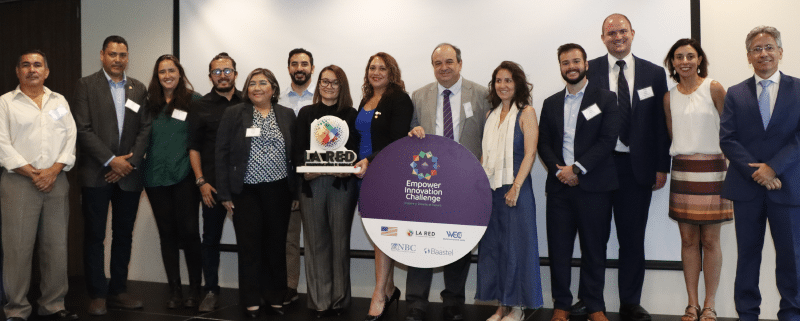For many corporate conservationists, attracting wildlife to a site is a major goal of their project. By offering adequate food and water sources and meeting habitat needs, corporate sites can become a haven for target local species, from white-tailed deer to bluebirds, painted turtles to monarch butterflies.
Once wildlife arrives on-site, it’s imperative to monitor populations and ensure the habitat continues to meet their needs — and of course, local animals are always fun to watch and learn from. But did you know wildlife can serve more than just an observational or educational purpose?
The wildlife species visiting a site do not have to be just an outcome of a project — they can also become “partners” in conservation efforts. This blog post will explore how the wildlife attracted to a thriving site further support the health of the environment by providing ecosystem services.
What are ecosystem services?
When wildlife naturally creates a benefit to the surrounding ecosystem or the people nearby, those benefits are called ecosystem services. There are four types of ecosystem services: provisioning, supporting, regulating and cultural.
Provisioning services are the tangible outputs of the environment, like fruits, water, timber and so on. Supporting services, such as nutrient cycling, uphold the health and function of the broader environment, serving as a foundation for all other ecosystem services. Regulating services, like carbon sequestration or erosion control, help to moderate natural processes in the environment, while cultural services provide non-tangible benefits to people like mental health improvements, educational opportunities or social cohesion.
Offering clues into the ecosystem’s health
One of the foundational ways that wildlife support greater conservation efforts is by indicating the health of the ecosystem. Certain species’ characteristics make them particularly helpful in this regard, and they are referred to as bioindicators.
Birds, for example, are very visible and thus easy to detect. They also have strict habitat requirements, and if an environment has changed in a way that no longer supports their needs, birds will leave — their absence serving as an indication that a detrimental environmental change has occurred. Reptiles and amphibians are also excellent bioindicators, as they are highly sensitive to pollution. Monitoring herptile populations through non-invasive methods like coverboard surveys provides insights into the enhancements needed for a thriving habitat.
Taking out invasive species
Invasive species are a serious threat to biodiversity. These non-native flora and fauna proliferate due to a lack of natural predators, outcompeting beneficial native species for resources. The introduction of natural predators to a site plagued by invasive species helps to restore balance. In fact, the use of predators to control invasives is called biological control and is considered a valid method of invasive species management.
Take purple loosestrife, for example. This invasive flora was unintentionally introduced to North America from Eurasia in the 1800s and has since spread to almost every Canadian province and nearly all U.S. states. The galerucella beetle feeds on purple loosestrife and has been used throughout the U.S. since 1992 to effectively control loosestrife infestations. These beetles are just one example of wildlife contributing to a more balanced, healthy ecosystem.
Of course, the introduction of one non-native species to combat another is a delicate operation, and it must be conducted only after extensive testing has determined that the introduced predator is safe to release. But when done effectively, biological control manages a troublesome invasive species while reducing the need for chemical herbicides or insecticides that have adverse effects on the rest of the ecosystem.
No need for a degree to be nature’s engineers
Some animals are adept at constructing habitat structures. Known as ecosystem engineers, these species will modify the environment to create a habitat for themselves, which in turn is sometimes used by other species as well. For example, chipmunks build tunnels, called burrows, to house their nests and stores of food. When chipmunks discontinue use of these burrows, snakes then use them for shelter.
While constructing their own habitats, ecosystem engineers often provide ecosystem services that benefit the rest of the ecosystem. Beavers are a prime example of beneficial ecosystem engineers, as their dams not only provide habitat, but they also support water quality and even help mitigate climate change impacts.
Sometimes, interference from beaver dams can cause issues, especially if it blocks important water flow. Non-lethal methods for coexisting with beavers include beaver deceivers and flow devices that restore the flow of the water body without harming or removing beavers.
Spreading the love (and the seeds)
Each season, a garden or forest habitat may need additional plantings to fill in gaps or replace plants. This task is where the ever-useful seed dispersers of the ecosystem can shine. Have you ever watched a squirrel bury an acorn and forget where they left it, resulting in an oak seeding? That’s animal seed dispersal in action.
From bison to bats, tons of animals disperse seeds, either by dropping them or by discarding fruit seeds after the digestion process. While seeds are naturally carried to other locations through means like gravity and wind, animal dispersion is an important method by which native plants proliferate.
Not only does seed dispersal allow for continued colonization by plant species, but it also ensures that the new seedlings have enough resources to survive without crowding or competing with others. When animals like birds, rodents or even insects carry and drop seeds in new locations, they are helping to support the area’s biodiversity — and corporate conservationists don’t need to do a thing!
Your weeds are their feeds
Keeping a grassland free of noxious weeds can be a full-time job. Not only are they consistent and time-consuming tasks, but weeding and mowing also utilize energy, emit greenhouse gases, incur high costs, create noise and disturb grass-dwelling wildlife. With all these downsides, a more sustainable alternative is welcome to many corporate conservation professionals.
Luckily, wildlife can once again be a valued partner in vegetation management efforts. Many species will feast on the weeds, grass and woody vegetation on a site, cutting down on the human-facilitated maintenance needed.
Grazing animals like cattle and sheep eat grass and low vegetation, while browsing species such as deer and giraffes feed on woody plants and leaves. Not only does allowing for grazing and browsing offer numerous benefits for corporate landowners, but it also provides an abundant supply of food for local wildlife. Depending on their diet, grazers and browsers can also target those pesky invasive species, and a lack of dry brush reduces fuel for potential wildfires.
Wildlife is an incredible asset to a conservation site — from invasive species control to engineering to seed dispersal, the ecosystem services they provide make animals powerful partners in conserving and supporting biodiversity.

